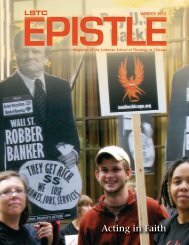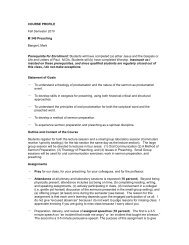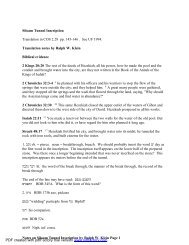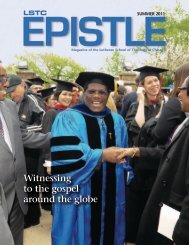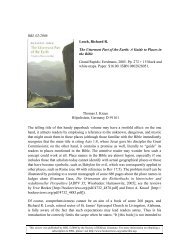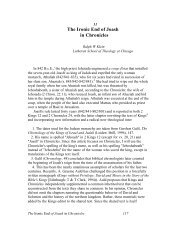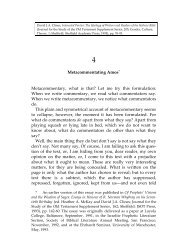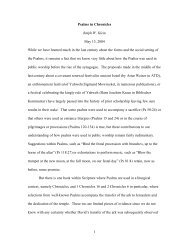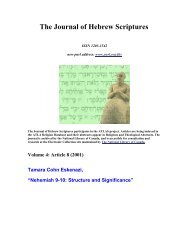Download this PDF file - University of Alberta - Journal Hosting
Download this PDF file - University of Alberta - Journal Hosting
Download this PDF file - University of Alberta - Journal Hosting
Create successful ePaper yourself
Turn your PDF publications into a flip-book with our unique Google optimized e-Paper software.
“IN CONVERSATION WITH ODED LIPSCHITS” 43Within <strong>this</strong> broad framework there is plenty <strong>of</strong> room for differentand contrasting ideas. 32 However, any attempt to drag <strong>this</strong> “middleway” reconstruction <strong>of</strong> the situation in Judah in the direction <strong>of</strong> a total“empty land” interpretation, 33 or in the direction <strong>of</strong> an argument fortotal continuity followed by the later creation <strong>of</strong> the “myth <strong>of</strong> the emptyland,” 34 derives, I think, from historical preconceptions about <strong>this</strong>period.This may also be the principle reason why the material culture <strong>of</strong><strong>this</strong> period was not identified until now in archaeological research. Theshort period <strong>of</strong> time that elapsed between the Babylonian destructionand the return is not a sufficient reason for the absence <strong>of</strong> finds, andmay represent an example <strong>of</strong> “structural habits <strong>of</strong> thought” inarchaeological research. Historical conclusions inform the chronologicaldivisions usually drawn in historical and archaeological research. In thecase <strong>of</strong> the Babylonian destruction, it can work only if one accepts thereconstruction <strong>of</strong> a total devastation <strong>of</strong> the land and a populationvacuum created because <strong>of</strong> it. Scholarly inability to assign materialculture to the 6 th century BCE, therefore, is a combination <strong>of</strong> twoelements:1. The fact that many <strong>of</strong> the archaeologists were neverlooking for material remains from <strong>this</strong> period. Thehistorical assumption <strong>of</strong> an empty land during the 6 thcentury BCE is a starting point for many archaeologicalstudies, and since nearly no one was looking for remainsfrom <strong>this</strong> period, nothing was found.2. If indeed people continued to live in Benjamin and in otherplaces in Judah after 586, we should expect the samematerial culture as before (pottery production, burialcustoms, building techniques etc.).The impact <strong>of</strong> historical preconceptions on archaeological researchcaused most archaeologists to assign all the finds familiar to them asbelonging to the late Iron Age to the period before 586 BCE. It iscorrect in the case <strong>of</strong> Jerusalem, Lachish and other places destroyed byHellenistic Palestine: Between Tradition and Renewal (Jerusalem: The Bialik Institute,2006).32 Cf., for example, the opposing opinions expressed by Vanderho<strong>of</strong>t onthe one side and Middlemas on the other: D.S. Vanderho<strong>of</strong>t, The Neo-BabylonianEmpire and Babylon in the Latter Prophets (HSM 59; Atlanta: Scholars Press, 1999);J. Middlemas, The Troubles <strong>of</strong> Templeless Judah (Oxford Theological Monographs;Oxford: Oxford <strong>University</strong> Press, 2005).33 See E. Stern's basic view in his Material Culture <strong>of</strong> the Land <strong>of</strong> the Bible in thePersian Period 538-332 B.C. (Warminster: Aris and Phillips / Jerusalem: IsraelExploration Society, 1982). See also Stern's 'The Babylonian Gap', BAR 26/6(2000), 45-51, 76, and also in his Archaeology <strong>of</strong> the Land <strong>of</strong> the Bible, vol. II: TheAssyrian, Babylonian, and Persian Periods 732-332 BCE (ABRL; New York:Doubleday, 2001), 303-50.34 See R. Carroll’s paper, “The Myth <strong>of</strong> the Empty Land,” Semeia 59 [1992]79-93, and H. Barstad's book, The Myth <strong>of</strong> the Empty Land: A Study in the Historyand Archaeology <strong>of</strong> Judah During the “Exilic” Period (Symbolae Osloenses, Fasc.Suppl. 28; Oslo: Scandinavian <strong>University</strong> Press, 1998).



